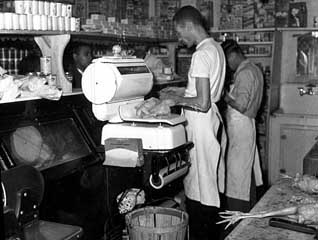Rondo Neighborhood
Between John Ireland Boulevard, University Avenue, Dunlap Street, and Selby Avenue, St. Paul, MN
| Interior of the Credjafawn Grocery Store on Rondo Avenue, 1948. |
Discriminatory hiring practices and restrictive home purchase agreements prevented St. Paul’s Black and Jewish communities from living in all parts of the city. These populations were forced to live on or near Rondo Avenue--the commercial heart of an integrated and vibrant neighborhood in the capital city.
It began as a predominantly Jewish area, and later transformed to a predominantly Black neighborhood as the city's Jewish population moved to more expensive homes in Highland Park. Rondo’s community maintained its neighborly connections even as the demographics changed dramatically. |
Churches (for the faithful), front porches (where entrepreneurs would visit with gossip and goods), numerous social clubs, the Hallie Q. Brown Community House, and illegal “good time houses” (gambling/drinking establishments set up in homes) all served as places of contact and neighborly communication.(1)
The manifestation of queer life on old Rondo is difficult to detect, let alone interpret according to contemporary (and European-influenced) understandings of LGBT people. Conservative churches affected the behavior and attitudes of the community. So did the strictures of racism and the threat of losing a family’s love—Rondo’s most precious commodity.
Young Black women didn’t dance together at sock hops as white women did,(2) and St. Paul’s cruising sites were possibly unwelcome to Black men. Because queer sites were unavailable, and community social events forbade displays of same-sex affection, queer activity likely took place discreetly in thousands of places within the neighborhood. Church choir meetings, particular “friendships” at individual homes, and after-dark streets are possible sites, as are every establishment and porch, depending on the time and place. One may assume that homosexual desire and behavior took place, but the details are specific to the individuals involved.
The neighborhood suffered a serious blow beginning in 1960, when the State Highway Department dug the trench for Interstate 94 just to the north of Rondo. The freeway dissected the community into two sections that are largely bereft of the same vitality they enjoyed as a whole.
(1)Fairbanks, Evelyn. Days of Rondo: A Warm Reminiscence of St. Paul’s Thriving Black Community in the 1930s and 1940s. St. Paul: Minnesota Historical Society Press, 1990.
(2)Fairbanks, page 152.
This page is still under construction. -SVC
Part of Minneapolis/St. Paul, MN: 100 Queer Places in Minnesota History, (1860-1969), (1969-2010)
